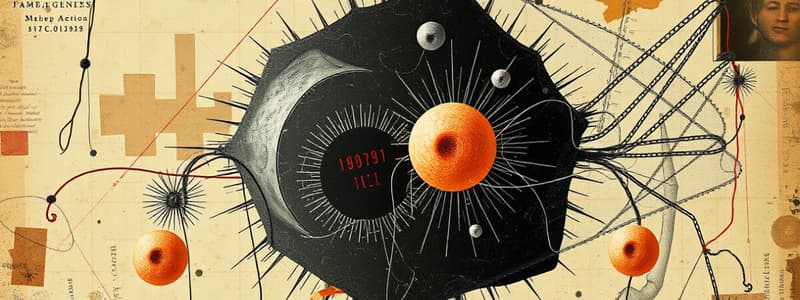Podcast
Questions and Answers
What is the primary result of meiosis in oogenesis?
What is the primary result of meiosis in oogenesis?
- Four haploid cells that are genetically distinct (correct)
- One diploid cell that undergoes further division
- Two diploid cells with identical genetic material
- Two genetically identical daughter cells
At what stage does oogenesis get arrested before parturition?
At what stage does oogenesis get arrested before parturition?
- Prophase I (correct)
- Telophase I
- Anaphase I
- Metaphase II
What characterizes the cells produced after meiosis I of oogenesis?
What characterizes the cells produced after meiosis I of oogenesis?
- They are tetraploid with 92 chromosomes
- They are diploid with 46 chromosomes
- They are haploid with 23 chromosomes but 46 chromatids (correct)
- They are genetically identical to the original cell
During which phase of meiosis does crossing over occur?
During which phase of meiosis does crossing over occur?
What type of cell division is mitosis classified as in oogenesis?
What type of cell division is mitosis classified as in oogenesis?
What type of cells do primary germ cells differentiate into in the ovary during fetal development?
What type of cells do primary germ cells differentiate into in the ovary during fetal development?
What is the chromosomal complement of a primary oocyte during prophase I of meiosis?
What is the chromosomal complement of a primary oocyte during prophase I of meiosis?
Which process introduces genetic variation during meiosis?
Which process introduces genetic variation during meiosis?
What event occurs at the ovulatory surge of LH?
What event occurs at the ovulatory surge of LH?
What is the purpose of polar bodies formed during oocyte development?
What is the purpose of polar bodies formed during oocyte development?
How many genetically distinct gametes can potentially be produced due to independent assortment in humans?
How many genetically distinct gametes can potentially be produced due to independent assortment in humans?
At which stage are most mammals born in relation to oogenesis?
At which stage are most mammals born in relation to oogenesis?
What is formed as a result of Meiosis I in oogenesis?
What is formed as a result of Meiosis I in oogenesis?
During which meiotic phase do homologous chromosomes exchange genetic material?
During which meiotic phase do homologous chromosomes exchange genetic material?
What is the total number of chromatids present after crossing over in homologous chromosomes?
What is the total number of chromatids present after crossing over in homologous chromosomes?
At what stage of meiosis does the secondary oocyte get arrested?
At what stage of meiosis does the secondary oocyte get arrested?
What occurs during ovulation?
What occurs during ovulation?
Where does fertilization typically occur?
Where does fertilization typically occur?
What happens to the polar body after meiosis?
What happens to the polar body after meiosis?
What is the genetic composition of an ovum?
What is the genetic composition of an ovum?
Which cells are responsible for testis development?
Which cells are responsible for testis development?
What is a primary germ cell called after it differentiates?
What is a primary germ cell called after it differentiates?
What is the duration of the fertilization window after ovulation?
What is the duration of the fertilization window after ovulation?
Which factor is crucial for the development of Leydig cells?
Which factor is crucial for the development of Leydig cells?
What role do Sertoli cells play in spermatogenesis?
What role do Sertoli cells play in spermatogenesis?
What is the primary function of Leydig cells in male physiology?
What is the primary function of Leydig cells in male physiology?
What is the significance of the blood testis barrier?
What is the significance of the blood testis barrier?
What type of cell is a spermatogonium?
What type of cell is a spermatogonium?
Which hormone is produced by Sertoli cells?
Which hormone is produced by Sertoli cells?
During which developmental stage do male mammals develop spermatogonium?
During which developmental stage do male mammals develop spermatogonium?
Flashcards are hidden until you start studying
Study Notes
Oogenesis Overview
- Oogenesis involves mitosis and meiosis for the formation of ova.
- Starts before parturition; oogonia (2n) undergo mitosis to form primary oocytes.
- Primary oocytes (2n & 4C) enter prophase I and get arrested until puberty.
Mitosis and Meiosis
- Mitosis produces two genetically identical diploid cells.
- Meiosis reduces chromosome number, creating four haploid cells.
- Crossing over occurs during meiosis I, promoting genetic diversity.
Meiosis Details
- Meiosis I separates homologous chromosomes; produces secondary oocyte and polar body.
- Secondary oocyte undergoes meiosis II, arrested at metaphase II until fertilization.
Polar Bodies
- Polar bodies arise from meiosis to reduce genetic material.
- Do not contribute to embryo development; degenerate post-formation.
Ovulation Process
- Ovulation releases the secondary oocyte from the follicle.
- Meiosis continues post-ovulation, blocked at metaphase II unless fertilized.
- Fertilization typically occurs in the ampulla of the uterine tube.
Male Fetal Life
- Spermatogonia originate from primary germ cells in fetal life.
- Undergo mitosis to produce diploid cells capable of forming sperm.
- Sertoli and Leydig cells develop, influenced by testosterone and other factors.
Spermatogenesis
- Spermatogenesis involves transformation from spermatogonia to sperm.
- Lower temperature (34 °C/93 °F) is optimal for sperm development.
- Requires 60 days overall for sperm maturation and transportation through the epididymis.
Sperm Structure
- Consists of head (with acrosome), midpiece (with mitochondria), and tail.
- Acrosome contains enzymes necessary for fertilization.
Role of the Epididymis
- Epididymis serves for sperm storage and maturation.
- Sperm gain motility and fertilization capability while in transit through the epididymis.
Puberty in Reproductive Competence
- Marked by gamete production and mating behavior changes.
- Increased secretion of GnRH and sensitivity to sex hormones.
- Both sexes show signs of reproductive readiness, with females acquiring cyclicity and males producing mature sperm.
Studying That Suits You
Use AI to generate personalized quizzes and flashcards to suit your learning preferences.



